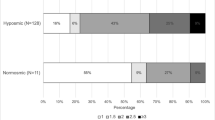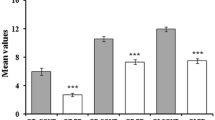Abstract
Background
Hyposmia is a common nonmotor symptom of Parkinson’s disease (PD) and reportedly associated with dysautonomia in PD. The smell identification test for measuring olfactory function consists of multiple items to discriminate specific scents. In the present study, factor analysis of the smell identification test was performed, and the correlation of extracted factors with cardiac sympathetic denervation (CSD) in patients with PD was investigated.
Methods
The present study included 183 early PD patients who underwent the Cross-Cultural Smell Identification Test (CC-SIT) and 123I-meta-iodobenzylguanidine (123I-MIBG) myocardial scintigraphy. Factor analysis of 12 items on the CC-SIT was performed using the computed correlation matrix for the binary items, and five smell factors were extracted. Multiple linear regression was performed to determine the correlation of olfactory function with late heart-to-mediastinum (H/M) ratio of 123I-MIBG uptake.
Results
The mean CC-SIT score was 6.1 ± 2.6, and 133 patients (72.7%) had CSD. The CC-SIT score and five smell factors were not associated with dopamine transporter uptake or cognitive functions. However, the CC-SIT score significantly correlated with age (P < 0.001) and late H/M ratio (P < 0.001). Factors 1 and 5 showed an increasing trend with larger H/M ratio, although it was not statistically significant (β = 0.203, P = 0.085 and β = 0.230, P = 0.085, respectively). Factor 5 significantly correlated with the H/M ratio in PD patients with CSD (β = 0.676, P = 0.036).
Discussion
The results showed olfactory dysfunction to be selectively associated with cardiac sympathetic burden in PD. The correlation of certain factors with CSD indicates the possibility of selective hyposmia in PD patients.

Similar content being viewed by others
Data availability
The data supporting the findings of this study are available from the corresponding author upon reasonable request.
Abbreviations
- CC-SIT:
-
Cross-cultural smell identification test
- CDR:
-
Clinical dementia rating
- CSD:
-
Cardiac sympathetic denervation
- 18F-FP-CIT:
-
18F-N-(3-fluoropropyl)-2beta-carbon ethoxy-3beta-(4-iodophenyl) nortropane
- H/M:
-
Heart-to-mediastinum
- H&Y:
-
Hoehn and Yahr Scale
- 123I-MIBG:
-
123I-meta-iodobenzylguanidine
- MMSE:
-
Mini-mental state examination
- PET:
-
Positron emission tomography
- PD:
-
Parkinson’s disease
- ROI:
-
Regions of interest
- SNSB:
-
Seoul neuropsychological screening battery
- SUVR:
-
Standardized uptake value ratio
- UPDRS:
-
Unified Parkinson’s Disease Rating Scale
References
Hubbard PS, Esiri MM, Reading M, McShane R, Nagy Z (2007) Alpha-synuclein pathology in the olfactory pathways of dementia patients. J Anat 211(1):117–124. https://doi.org/10.1111/j.1469-7580.2007.00748.x
Stokholm MG, Danielsen EH, Hamilton-Dutoit SJ, Borghammer P (2016) Pathological α-synuclein in gastrointestinal tissues from prodromal Parkinson disease patients. Ann Neurol 79(6):940–949. https://doi.org/10.1002/ana.24648
Orimo S, Takahashi A, Uchihara T, Mori F, Kakita A, Wakabayashi K et al (2007) Degeneration of cardiac sympathetic nerve begins in the early disease process of Parkinson’s disease. Brain Pathol 17(1):24–30. https://doi.org/10.1111/j.1750-3639.2006.00032.x
Schapira AHV, Chaudhuri KR, Jenner P (2017) Non-motor features of Parkinson disease. Nat Rev Neurosci 18(7):435–450. https://doi.org/10.1038/nrn.2017.62
Postuma RB, Berg D (2016) Advances in markers of prodromal Parkinson disease. Nat Rev Neurol 12(11):622–634. https://doi.org/10.1038/nrneurol.2016.152
Bohnen NI, Studenski SA, Constantine GM, Moore RY (2008) Diagnostic performance of clinical motor and non-motor tests of Parkinson disease: a matched case-control study. Eur J Neurol 15(7):685–691. https://doi.org/10.1111/j.1468-1331.2008.02148.x
Mao CJ, Wang F, Chen JP, Yang YP, Chen J, Huang JY et al (2017) Odor selectivity of hyposmia and cognitive impairment in patients with Parkinson’s disease. Clin Interv Aging 12:1637–1644. https://doi.org/10.2147/CIA.S147588
Bohnen NI, Gedela S, Herath P, Constantine GM, Moore RY (2008) Selective hyposmia in Parkinson disease: association with hippocampal dopamine activity. Neurosci Lett 447(1):12–16. https://doi.org/10.1016/j.neulet.2008.09.070
Double KL, Rowe DB, Hayes M, Chan DK, Blackie J, Corbett A et al (2003) Identifying the pattern of olfactory deficits in Parkinson disease using the brief smell identification test. Arch Neurol 60(4):545–549. https://doi.org/10.1001/archneur.60.4.545
Daum RF, Sekinger B, Kobal G, Lang CJ (2000) Olfactory testing with “sniffin’ sticks” or clinical diagnosis of Parkinson disease. Nervenarzt 71(8):643–650. https://doi.org/10.1007/s001150050640
Hawkes CH, Shephard BC (1993) Selective anosmia in Parkinson’s disease? Lancet 341(8842):435–436
Hähner A, Maboshe W, Baptista RB, Storch A, Reichmann H, Hummel T (2013) Selective hyposmia in Parkinson’s disease? J Neurol 260(12):3158–3160. https://doi.org/10.1007/s00415-013-7153-2
Lamotte G, Holmes C, Sullivan P, Lenka A, Goldstein DS (2020) Cardioselective peripheral noradrenergic deficiency in Lewy body synucleinopathies. Ann Clin Transl Neurol 7(12):2450–2460. https://doi.org/10.1002/acn3.51243
Takahashi M, Ikemura M, Oka T, Uchihara T, Wakabayashi K, Kakita A et al (2015) Quantitative correlation between cardiac MIBG uptake and remaining axons in the cardiac sympathetic nerve in Lewy body disease. J Neurol Neurosurg Psychiatry 86(9):939–944. https://doi.org/10.1136/jnnp-2015-310686
Lee PH, Yeo SH, Kim HJ, Youm HY (2006) Correlation between cardiac 123I-MIBG and odor identification in patients with Parkinson’s disease and multiple system atrophy. Mov Disord 21(11):1975–1977. https://doi.org/10.1002/mds.21083
Mizutani Y, Nakamura T, Okada A, Suzuki J, Watanabe H, Hirayama M et al (2014) Hyposmia and cardiovascular dysautonomia correlatively appear in early-stage Parkinson’s disease. Parkinsonism Relat Disord 20(5):520–524. https://doi.org/10.1016/j.parkreldis.2014.02.010
Wang XY, Han YY, Li G, Zhang B (2019) Association between autonomic dysfunction and olfactory dysfunction in Parkinson’s disease in southern Chinese. BMC Neurol 19(1):17. https://doi.org/10.1186/s12883-019-1243-4
Gibb WR, Lees AJ (1988) The relevance of the Lewy body to the pathogenesis of idiopathic Parkinson’s disease. J Neurol Neurosurg Psychiatry 51(6):745–752. https://doi.org/10.1136/jnnp.51.6.745
Postuma RB, Berg D, Stern M, Poewe W, Olanow CW, Oertel W et al (2015) MDS clinical diagnostic criteria for Parkinson’s disease. Mov Disord 30(12):1591–1601. https://doi.org/10.1002/mds.26424
Ryu HJ, Yang DW (2023) The Seoul Neuropsychological Screening Battery (SNSB) for comprehensive neuropsychological assessment. Dement Neurocogn Disord 22(1):1–15. https://doi.org/10.12779/dnd.2023.22.1.1
Gibbons CH, Schmidt P, Biaggioni I, Frazier-Mills C, Freeman R, Isaacson S et al (2017) The recommendations of a consensus panel for the screening, diagnosis, and treatment of neurogenic orthostatic hypotension and associated supine hypertension. J Neurol 264(8):1567–1582. https://doi.org/10.1007/s00415-016-8375-x
Doty RL, Marcus A, Lee WW (1996) Development of the 12-item cross-cultural smell identification test (CC-SIT). Laryngoscope 106(3 Pt 1):353–356. https://doi.org/10.1097/00005537-199603000-00021
Ryu DW, Kim JS, Lee JE, Oh YS, Yoo SW, Yoo IR et al (2019) Initial versus follow-up sequential myocardial 123I-MIBG scintigraphy to discriminate Parkinson disease from atypical parkinsonian syndromes. Clin Nuclear Med 44(4):282–288. https://doi.org/10.1097/RLU.0000000000002424
Horsager J, Knudsen K, Sommerauer M (2022) Clinical and imaging evidence of brain-first and body-first Parkinson’s disease. Neurobiol Dis 164:105626. https://doi.org/10.1016/j.nbd.2022.105626
Iijima M, Osawa M, Momose M, Kobayakawa T, Saito S, Iwata M et al (2010) Cardiac sympathetic degeneration correlates with olfactory function in Parkinson’s disease. Mov Disord 25(9):1143–1149. https://doi.org/10.1002/mds.23001
Ubeda-Bañon I, Saiz-Sanchez D, de la Rosa-Prieto C, Martinez-Marcos A (2014) α-Synuclein in the olfactory system in Parkinson’s disease: role of neural connections on spreading pathology. Brain Struct Funct 219(5):1513–1526. https://doi.org/10.1007/s00429-013-0651-2
Horsager J, Andersen KB, Knudsen K, Skjærbæk C, Fedorova TD, Okkels N et al (2020) Brain-first versus body-first Parkinson’s disease: a multimodal imaging case-control study. Brain 143(10):3077–3088. https://doi.org/10.1093/brain/awaa238
Ryu DW, Yoo SW, Oh YS, Lee KS, Ha S, Kim JS (2022) Comparison of disease progression between brain-predominant Parkinson’s disease versus Parkinson’s disease with body-involvement phenotypes. Neurobiol Dis 174:105883. https://doi.org/10.1016/j.nbd.2022.105883
Knudsen K, Fedorova TD, Horsager J, Andersen KB, Skjærbæk C, Berg D et al (2021) Asymmetric dopaminergic dysfunction in brain-first versus body-first Parkinson’s disease subtypes. J Parkinsons Dis 11(4):1677–1687. https://doi.org/10.3233/JPD-212761
Ercoli T, Masala C, Cadeddu G, Mascia MM, Orofino G, Gigante AF et al (2022) Does olfactory dysfunction correlate with disease progression in Parkinson’s disease? A systematic review of the current literature. Brain Sci 12(5):513. https://doi.org/10.3390/brainsci12050513
Yoo HS, Chung SJ, Lee YH, Ye BS, Sohn YH, Lee PH (2020) Association between olfactory deficit and motor and cognitive function in Parkinson’s disease. J Mov Disord 13(2):133–141. https://doi.org/10.14802/jmd.19082
Masala C, Solla P, Liscia A, Defazio G, Saba L, Cannas A et al (2018) Correlation among olfactory function, motors’ symptoms, cognitive impairment, apathy, and fatigue in patients with Parkinson’s disease. J Neurol 265(8):1764–1771. https://doi.org/10.1007/s00415-018-8913-9
Kim JS, Park HE, Park IS, Oh YS, Ryu DW, Song IU et al (2017) Normal ‘heart’ in Parkinson’s disease: is this a distinct clinical phenotype? Eur J Neurol 24(2):349–356. https://doi.org/10.1111/ene.13206
Papazian EJ, Pinto JM (2021) Olfactory loss and aging: connections with health and well-being. Chem Senses 46:bjab045. https://doi.org/10.1093/chemse/bjab045
Yang Z, Xie Y, Dou K, Yang L, Xie A (2023) Associations of striatal dopamine transporter binding with motor and non-motor symptoms in early Parkinson’s disease. Clin Transl Sci 16(6):1021–1038. https://doi.org/10.1111/cts.13508
Meles SK, Oertel WH, Leenders KL (2021) Circuit imaging biomarkers in preclinical and prodromal Parkinson’s disease. Mol Med 27(1):111. https://doi.org/10.1186/s10020-021-00327-x
Schwarz J, Storch A, Koch W, Pogarell O, Radau PE, Tatsch K (2004) Loss of dopamine transporter binding in Parkinson’s disease follows a single exponential rather than linear decline. J Nucl Med 45(10):1694–1697
Bohnen NI, Müller ML (2013) In vivo neurochemical imaging of olfactory dysfunction in Parkinson’s disease. J Neural Transm (Vienna) 120(4):571–576. https://doi.org/10.1007/s00702-012-0956-y
Solla P, Masala C, Ercoli T, Frau C, Bagella C, Pinna I et al (2023) Olfactory impairment correlates with executive functions disorders and other specific cognitive dysfunctions in Parkinson’s disease. Biology (Basel) 12(1):112. https://doi.org/10.3390/biology12010112
Cecchini MP, Federico A, Zanini A, Mantovani E, Masala C, Tinazzi M et al (2019) Olfaction and taste in Parkinson’s disease: the association with mild cognitive impairment and the single cognitive domain dysfunction. J Neural Transm (Vienna) 126(5):585–595. https://doi.org/10.1007/s00702-019-01996-z
Camargo CHF, Jobbins VA, Serpa RA, Berbetz FA, Sabatini JS, Teive HAG (2018) Association between olfactory loss and cognitive deficits in Parkinson’s disease. Clin Neurol Neurosurg 173:120–123. https://doi.org/10.1016/j.clineuro.2018.08.018
Bohnen NI, Gedela S, Kuwabara H, Constantine GM, Mathis CA, Studenski SA et al (2007) Selective hyposmia and nigrostriatal dopaminergic denervation in Parkinson’s disease. J Neurol 254(1):84–90. https://doi.org/10.1007/s00415-006-0284-y
Trentin S, Fraiman de Oliveira BS, Ferreira Felloni Borges Y, de Mello Rieder CR (2022) Systematic review and meta-analysis of Sniffin sticks test performance in Parkinson’s disease patients in different countries. Eur Arch Otorhinolaryngol 279(3):1123–1145. https://doi.org/10.1007/s00405-021-06970-8
Cersosimo MG, Benarroch EE, Raina GB (2021) Lewy bodies in the olfactory system and the hypothalamus. Handb Clin Neurol 182:235–244. https://doi.org/10.1016/B978-0-12-819973-2.00016-2
Bang Y, Lim J, Choi HJ (2021) Recent advances in the pathology of prodromal non-motor symptoms olfactory deficit and depression in Parkinson’s disease: clues to early diagnosis and effective treatment. Arch Pharm Res 44(6):588–604. https://doi.org/10.1007/s12272-021-01337-3
Lee YH, Bak Y, Park CH, Chung SJ, Yoo HS, Baik K et al (2020) Patterns of olfactory functional networks in Parkinson’s disease dementia and Alzheimer’s dementia. Neurobiol Aging 89:63–70. https://doi.org/10.1016/j.neurobiolaging.2019.12.021
Morley JF, Cohen A, Silveira-Moriyama L, Lees AJ, Williams DR, Katzenschlager R et al (2018) Optimizing olfactory testing for the diagnosis of Parkinson’s disease: item analysis of the university of Pennsylvania smell identification test. NPJ Parkinsons Dis 4:2. https://doi.org/10.1038/s41531-017-0039-8
Funding
This research was supported by Basic Science Research Program through the National Research Foundation of Korea (NRF) funded by the Ministry of Science, ICT and Future Planning (NRF-2017R1D1A1B06028086). This research was also supported by the Korea “National Institute of Health” research project (2021-ER1008-02).
Author information
Authors and Affiliations
Contributions
Conceptualization: DWR, JSK. Methodology: DWR, JSK. Formal analysis and investigation: DWR, SWY, KEC, YSO, JSK. Writing—original draft preparation: DWR. Writing—review and editing: SWY, KEC, YSO, JSK. Funding acquisition: JSK. Resources: DWR, JSK. Approval of final manuscript: DWR, SWY, KEC, YSO, JSK.
Corresponding author
Ethics declarations
Conflicts of interest
The authors report no disclosures relevant to the manuscript.
Supplementary Information
Below is the link to the electronic supplementary material.
Rights and permissions
Springer Nature or its licensor (e.g. a society or other partner) holds exclusive rights to this article under a publishing agreement with the author(s) or other rightsholder(s); author self-archiving of the accepted manuscript version of this article is solely governed by the terms of such publishing agreement and applicable law.
About this article
Cite this article
Ryu, DW., Yoo, SW., Choi, KE. et al. Correlation of olfactory function factors with cardiac sympathetic denervation in Parkinson’s disease. J Neurol 271, 1397–1407 (2024). https://doi.org/10.1007/s00415-023-12080-8
Received:
Revised:
Accepted:
Published:
Issue Date:
DOI: https://doi.org/10.1007/s00415-023-12080-8




